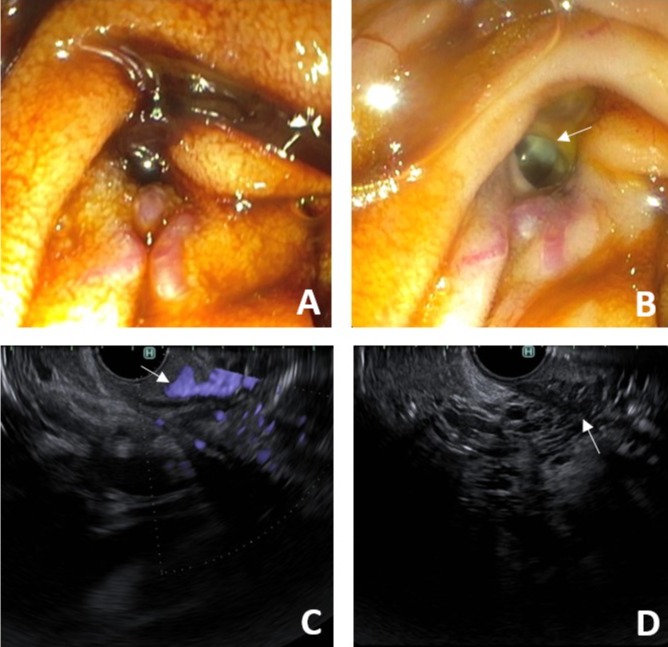Monday Poster Session
Category: Interventional Endoscopy
P2334 - Varices at Choledochojejunostomy Site as the Elusive Gastrointestinal Bleeding Source in a Post-Whipple Patient
Monday, October 23, 2023
10:30 AM - 4:15 PM PT
Location: Exhibit Hall

Has Audio
- KV
Kassidy Veasaw, DO
Westchester Medical Center
Valhalla, NY
Presenting Author(s)
Kassidy Veasaw, DO, Zilan Lin, MD, Anila Kumar, DO, Shireen Pais, MD
Westchester Medical Center, Valhalla, NY
Introduction: Variceal bleeding most commonly occurs at the gastroesophageal junction and is often a consequence of portal hypertension. Ectopic varices are portosystemic collaterals in locations other than the gastroesophageal region and account for a small portion of all gastrointestinal variceal bleeding. Ectopic varices account for only 2-5% of all varices that bleed, and of these, jejunal varices account for merely 17%.
Case Description/Methods: An 80-year-old man with a history of pancreatic cancer, previously underwent neoadjuvant chemoradiation therapy followed by a Whipple procedure, in remission for 3 years, and presented with one month of intermittent hematochezia. Despite multiple upper endoscopies, push enteroscopies, colonoscopies, tagged red blood cell scans and CT angiogram over a month-long hospitalization, the exact location of a bleeding source could not be identified. Eventually, he underwent another esophagogastroduodenoscopy with endoscopic ultrasound. A large blood clot was noted at the choledochojejunostomy site, which was dislodged and underneath a few prominent grapelike clusters consistent with varices were seen surrounding the anastomosis. This was determined to be the likely source of bleeding, and he underwent embolization with concerto and pod coils by interventional radiology. This controlled the bleed and he was discharged with no further hematochezia.
Discussion: Development of ectopic varices is uncommon, and identifying bleeding at these sites can be difficult. Our patient was found to have severe stenosis at the confluence of the superior mesenteric, splenic and portal vein demonstrated on angiography. Without any other etiology identified for portal hypertension in this patient, the physiological changes due to anatomical alteration from pancreaticoduodenectomy was the likely source of extrahepatic portal hypertension and development of ectopic varices. Treatment options include endoscopic glue injection therapy with cyanoacrylate, balloon angioplasty, endoscopic variceal band ligation, transjugular intrahepatic portosystemic shunt and transcatheter variceal embolization as in this case. Successful treatment of these patients entails addressing individualized needs of the underlying cause of portal hypertension. Ectopic variceal bleeding should be included in the differential of gastrointestinal bleeding in patients that are status post-pancreaticoduodenectomy.

Disclosures:
Kassidy Veasaw, DO, Zilan Lin, MD, Anila Kumar, DO, Shireen Pais, MD. P2334 - Varices at Choledochojejunostomy Site as the Elusive Gastrointestinal Bleeding Source in a Post-Whipple Patient, ACG 2023 Annual Scientific Meeting Abstracts. Vancouver, BC, Canada: American College of Gastroenterology.
Westchester Medical Center, Valhalla, NY
Introduction: Variceal bleeding most commonly occurs at the gastroesophageal junction and is often a consequence of portal hypertension. Ectopic varices are portosystemic collaterals in locations other than the gastroesophageal region and account for a small portion of all gastrointestinal variceal bleeding. Ectopic varices account for only 2-5% of all varices that bleed, and of these, jejunal varices account for merely 17%.
Case Description/Methods: An 80-year-old man with a history of pancreatic cancer, previously underwent neoadjuvant chemoradiation therapy followed by a Whipple procedure, in remission for 3 years, and presented with one month of intermittent hematochezia. Despite multiple upper endoscopies, push enteroscopies, colonoscopies, tagged red blood cell scans and CT angiogram over a month-long hospitalization, the exact location of a bleeding source could not be identified. Eventually, he underwent another esophagogastroduodenoscopy with endoscopic ultrasound. A large blood clot was noted at the choledochojejunostomy site, which was dislodged and underneath a few prominent grapelike clusters consistent with varices were seen surrounding the anastomosis. This was determined to be the likely source of bleeding, and he underwent embolization with concerto and pod coils by interventional radiology. This controlled the bleed and he was discharged with no further hematochezia.
Discussion: Development of ectopic varices is uncommon, and identifying bleeding at these sites can be difficult. Our patient was found to have severe stenosis at the confluence of the superior mesenteric, splenic and portal vein demonstrated on angiography. Without any other etiology identified for portal hypertension in this patient, the physiological changes due to anatomical alteration from pancreaticoduodenectomy was the likely source of extrahepatic portal hypertension and development of ectopic varices. Treatment options include endoscopic glue injection therapy with cyanoacrylate, balloon angioplasty, endoscopic variceal band ligation, transjugular intrahepatic portosystemic shunt and transcatheter variceal embolization as in this case. Successful treatment of these patients entails addressing individualized needs of the underlying cause of portal hypertension. Ectopic variceal bleeding should be included in the differential of gastrointestinal bleeding in patients that are status post-pancreaticoduodenectomy.

Figure: A: Hematin overlying numerous varices at the choledochojejunostomy site
B: Numerous varices and bile duct (arrow) at choledochojejunostomy site
C: EUS showing large intramural varix (arrow) and many small extraluminal varices
D: EUS showing numerous intramural and extramural varices surrounding the muscularis propria (arrow)
B: Numerous varices and bile duct (arrow) at choledochojejunostomy site
C: EUS showing large intramural varix (arrow) and many small extraluminal varices
D: EUS showing numerous intramural and extramural varices surrounding the muscularis propria (arrow)
Disclosures:
Kassidy Veasaw indicated no relevant financial relationships.
Zilan Lin indicated no relevant financial relationships.
Anila Kumar indicated no relevant financial relationships.
Shireen Pais indicated no relevant financial relationships.
Kassidy Veasaw, DO, Zilan Lin, MD, Anila Kumar, DO, Shireen Pais, MD. P2334 - Varices at Choledochojejunostomy Site as the Elusive Gastrointestinal Bleeding Source in a Post-Whipple Patient, ACG 2023 Annual Scientific Meeting Abstracts. Vancouver, BC, Canada: American College of Gastroenterology.
